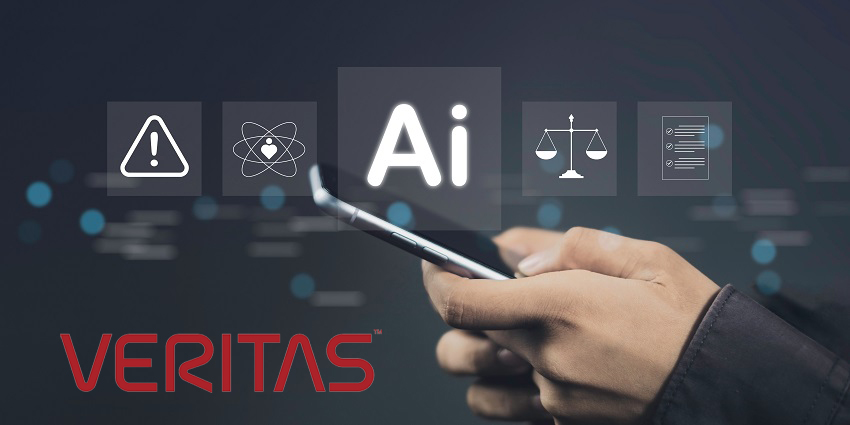Artificial Intelligence has come a long way in the last couple of years. The development of newer, more powerful AI models, generative AI applications, and LLMs has revolutionized virtually every business. Today’s intelligent systems support countless use cases, from helping businesses deliver exceptional customer service, to creating unique content.
For eComms surveillance, given the rapid growth in electronic communications and the increase in number of channels on which we communicate, “AI based monitoring is no longer a nice to have but a must have,” says Chris Stapenhurst from Veritas, a leading eComms surveillance provider.
However, rapid worldwide adoption of generative AI has also raised various concerns related to accuracy, bias, intellectual property protection, data privacy, and exploitation. As a result, various governments and regulatory bodies have begun introducing new governance guidelines for AI usage.
Staying ahead of these regulations, earning consumer trust, and protecting data requires companies to take a new approach to data governance, and surveillance.
Governing AI Solutions: The Evolving Regulations
There’s no doubt that AI, and generative AI in particular, can deliver countless benefits to businesses. In the communications and analytics space, for instance, GenAI can automate the generation of reports, summarize huge volumes of data, and assist businesses in making informed decisions.
Leading solutions can leverage advanced algorithms and machine learning models to optimize supply chains, predict customer behavior, and even accelerate the development of new products and solutions. Plus, generative AI’s ability to analyze data rapidly and search for relevant patterns can even help businesses fight back against security issues and fraud.
However, generative AI suffers from a range of issues. It can confidently deliver incorrect answers to queries, demonstrate bias when it’s trained on incomplete data, and be used by malicious actors for data theft and other nefarious purposes.
As a result, regulators like FINRA, as well as groups like the Biden administration in the US, and the European Union, are introducing new guidelines for safe generative AI use.
AI Safety Basics: The Core Concepts of Governing AI
Though there’s no globally approved set of governance guidelines for generative AI yet, the US Executive Order Of AI Safety, the EU AI Act, and even FINRA’s regulations focus on a few overlapping areas. Companies embracing AI will need to ensure they’re prioritizing:
AI Transparency and Reliability
The fight against “black box AI” is growing. Regulators want organizations to show they understand how models arrive at specific conclusions. This means leveraging clear documentation and explanations of how models work.
Additionally, many governance guidelines suggest that AI models should be able to consistently produce dependable, accurate results. Leading surveillance tools, such as those offered by Veritas, can assist companies in maintaining the transparency and reliability of their models.
With end-to-end insights into how AI systems perform, companies can more rapidly identify potential issues where AI systems make errors in their responses. They can then dive into the AI model they’re using, to identify how those systems came up with those responses, and optimize algorithms.
“The solution must be able to demonstrate how the AI is coming up with its determinations. Failure do so, leads can lead to hallucinations, bias, security, privacy and other compliance breaches as well as limit our ability to defend AI’s use in the first place,” continues Stapenhurst.
Bias Mitigation
Bias is a common issue for generative AI models. While these systems aren’t inherently biased, training with the wrong data can cause them to arrive at biased conclusions. Overcoming the issue of bias in AI models requires a comprehensive approach. Throughout the AI lifecycle, from the point of data collection, through to pre-processing and model development, companies will need to implement testing strategies, data governance efforts, and regular audits.
Ensuring models are trained with comprehensive, accurate, and high-quality data sets is a good first step. With the right data governance strategy, companies can implement data management practices to help ensure data is accurate, consistent, and compliant.
Monitoring AI conversations, with an end-to-end surveillance tool, will allow organizations to identify instances of bias, and determine how to train and fine-tune systems to eliminate these issues.
Data Privacy, Protection and Security
Large volumes of high-quality data are crucial in developing powerful, capable, and diverse AI models. However, many government groups implementing AI regulations are building on standards like GDPR and CCPA, to ensure organizations are still keeping sensitive data private and protected.
Organizations implementing AI models into their communication strategies and ecosystems will need to ensure they’re feeding models the right data. This means once again using data governance strategies and data classification tools to identify potentially sensitive data that should not be shared with AI models.
Anonymization techniques can be particularly valuable when it comes to ensuring that AI systems can learn about your customers and users, without putting private information at risk.
They’ll also need to consider carefully how that data is secured and stored. All data shared with an AI system should be encrypted and protected. There may also be a need for companies in highly regulated industries to leverage data masking and anonymization tools.
Accountability
Accountability is another core issue raised by many governance standards affecting AI usage. Organizations leveraging AI systems need to establish clear lines of accountability, defining who is responsible for the model’s actions and decisions.
Ensuring teams have the tools they need to effectively monitor AI throughout the communications ecosystem, identify errors, and eliminate potential risks will be essential. Business leaders will need to establish clear protocols and identify specific team members responsible for model development, validation, and surveillance.
Additionally, teams using AI will need access to comprehensive training, helping them to understand which regulations and guidelines they need to adhere to in their day-to-day work.
Ethical Use
Finally, companies will need to ensure they understand the ethical implications of AI, and implement strategies to prevent unethical usage. Creating clear AI policies, which ensure AI is used in fair, and just ways, will be critical.
Ethical guidelines for AI usage should address various concepts, such as fairness, transparency, and accountability, and ensure businesses have a framework in place for maintaining ongoing ethical decision-making processes with AI tools.
Again, surveillance solutions will be able to help organizations to more effectively track the use of AI solutions, and ensure all stakeholders are adhering to ethical guidelines.
Managing AI Governance Concerns in Communications
Comprehensive governance frameworks will be essential to ensuring the generative AI systems businesses use are reliable, trustworthy, and ethical. While there’s no one-size-fits-all approach to navigating governance concerns, a holistic approach to implementing practices and policies that assist businesses in monitoring and fine-tuning AI tools will be essential.
With an end-to-end platform for digital communications surveillance, businesses can preserve a clear view of their AI solutions, boosting transparency, accountability, and data security.
For more information on Veritas Surveillance, click here.
As well as a whitepaper on Intelligent Review Machine Learning for Surveillance, which you can read here.







